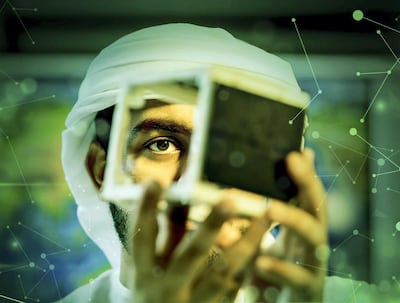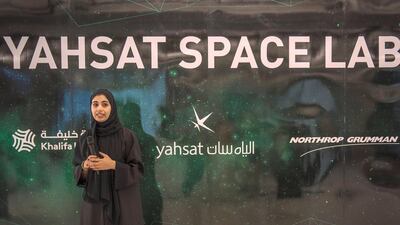The UAE has cemented its position as a growing global player in space exploration after a satellite built and developed by UAE students was launched on Saturday.
The country's space programme hit another major milestone when MYSAT-1, crafted by a team of about 20 students at Khalifa University, was sent soaring into the skies on a rocket that took off from Wallops Island in Virginia in the east of the United States.
MYSAT-1 was one of a number of satellites taken up by an International Space Station-bound Antares 230 rocket launched from the Mid-Atlantic Regional Spaceport.
The result of a three-year project, MYSAT-1 weighs just 1.3kg and is a type of CubeSat, a small satellite made up of cube-shaped units 10cm in size.
It has a camera that will take pictures of Earth, and will also be used to test a lithium-ion battery created at Khalifa University.
“While not the first nano-satellite developed in the UAE, MYSAT-1 is among the first to be developed by local students who have been taught within the country, at one of the UAE’s own universities,” Khaled Al Hashmi, senior director of space missions at the UAE Space Agency, said in a statement.
MYSAT-1 was designed and built by master's degree students studying space systems and technology. The university's programme was developed with Al Yah Satellite Communications Company (Yahsat), which is owned by Mubadala, and the American defence and aerospace giant Northrop Grumman. The construction of MYSAT-1 took place at the Yahsat Space Lab in Masdar City.
The launch from Wallops Island, carried out by Northrop Grumman as part of a contract with NASA, comes just weeks after another UAE space-related take-off.
In October, the launch took place of a satellite called KhalifaSat, which was developed at the Mohammed Bin Rashid Space Centre by Emirati space scientists. The project was supervised by the UAE Space Agency.
____________
Read more:
First satellite built at Abu Dhabi lab heads to International Space Station
Yahsat to launch third satellite in January and expand into Brazil
Exclusive: Yahsat's new satellite to service mobility and Internet of Things, driving growth
____________
“The UAE's space sector is now in a phase where we are witnessing accelerating progress as we move towards the launch of the Hope Probe in 2020,” added Mr Al Hashmi, referring to the UAE's Mars probe.
Students at other universities around the world have developed and built CubeSats and the experience can prove enormously valuable, according to Professor Alan Smith of University College London (UCL).
UCL academics have built satellites, and Prof Smith, who has worked for the European Space Agency, has links to a programme in Dublin, Ireland, in which students create satellites. He said this programme shows the benefits of getting students to build satellites.
“It's extraordinarily effective in engendering an enthusiasm in space and a holistic view of the topic,” he said.
“For people getting into the space business it's really a useful thing to do. It's hands-on, but in a multifaceted way. Students can always find a part of it that interests them.”

For example, he said some students might be interested in operations, others in software coding or in antennae, sometimes working in teams of six to eight people. Many components that they use can be bought online and assembled into the satellite.
“That assembly is a lot more difficult than it seems. The parts may not fit together perfectly. A lot of testing has to be done. A lot of systems work has to be done,” said Prof Smith
“It's a very good training aid. It gets the students to understand the life-cycle and complexity of a whole satellite. That's a very powerful tool.”
Many satellites built by students are not actually launched, so in that respect the UAE project stands apart from those at some other universities.
“I would caution though that the launch of a CubeSat is only a very early step towards becoming a major space player. Significant internal investment will be required and the Mars mission is a big step up. Good luck to them,” Prof Smith of the UAE's space initiatives.
As well as the Mars probe, the UAE space programme also has the aim of sending an Emirati astronaut to the International Space Station next year through a collaboration with Russia's Roscosmos federal space agency.
Saturday's launch involved the Antares rocket carrying a Cygnus spacecraft that had a cargo of more than three tonnes, including a number of satellites, equipment linked to experiments, including a 3D printer and recycler, and supplies of food for crew. After Cygnus docks at the International Space Station, MYSAT-1 and two other CubeSats will be deployed.


